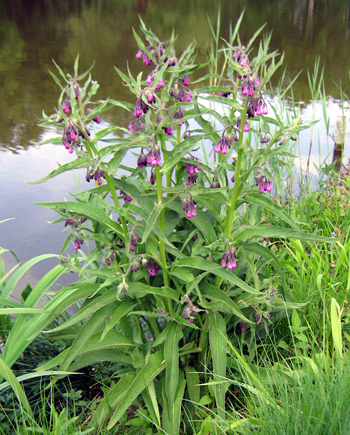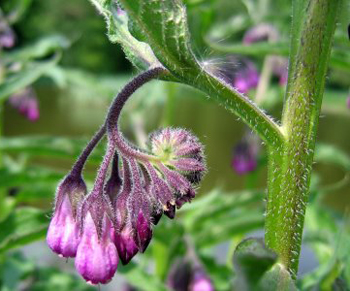Contents:
Common Names | Parts Usually Used | Plant(s) & Culture | Where Found | Medicinal Properties | Biochemical Information
Legends, Myths and Stories | Uses | Formulas or Dosages | Nutrient Content | How Sold | Warning | Bibliography
Scientific Names
 |
- Symphytum officinale L.
- Boraginaceae
- Borage family
Common Names
- All-heal
- Ass ear
- Blackwort
- Bruisewort
- Gum plant
- Healing herb
- Knitback
- Knitbone
- Nipbone
- Salsify
- Slippery root
- Wallwort
Parts Usually Used
Leaves and root
Back to Top
Description of Plant(s) and Culture
 |
Comfrey is a perennial plant 1-3 feet tall; the large rootstock is black outside, fleshy and whitish inside, and contains a glutinous juice. The angular, hairy stem bears bristly, oblong lanceolate leaves, some petioled, some sessile. There are also tongue-shaped, fuzzy, basal leaves that generally lie on the ground. The whitish, pink, or pale purple bell-like flowers have a tubular corolla resembling the finger of a glove and grow in forked racemes from May to August. Full sun or partial shade. Zones 5-9.
Back to Top
Where Found
Moist meadows, ditches, and other moist places in the United States and Europe.
Back to Top
Medicinal Properties
Anodyne, astringent, demulcent, emollient, expectorant, hemostatic, refrigerant, tonic, vulnerary
Back to Top
Biochemical Information
Allantoin (mainly flowering tops), consolidine, inulin, mucilage, alkaloids (mainly root), steroidal saponins, phosphorus, potassium, pyrroliziidine, starch, tannins, and vitamins A, B12, C, and E.
Back to Top
Legends, Myths and Stories
 |
There are 25 species of comfrey used in most herb books, a number of the 25 species are cultivated in American gardens. Comfrey is native to Europe, Asia Minor, Siberia and Iran.
The country name for comfrey was knitbone, a reminder of its traditional use in healing fractures. The herb contains allantoin, which encourages bone, cartilage, and muscle cells to grow. When the crushed herb is applied to an injured limb, the allantoin is absorbed through the skin and speeds up healing. In the past, comfrey baths were popular before marriage to repair the hymen and thus “restore virginity.”
Comfrey was extremely popular in the 1970’s and early 1980’s, but studies showing toxic pyrroliziidine alkaloids, especially in the root, have tempered the enthusiasm for comfrey. Recent studies show that leaves harvested during the blooming period (May to September) are very low in alkaloid content. Suspected carcinogen.
Comfrey contains allantoin, a substance that helps stimulate the growth of new cells and is now used in many cosmetic products. Commercially prepared comfrey creams and ointments are useful for all kinds of skin irritations, including chafing and bug bites. Today, we are more cautious about taking comfrey internally, because it contains pyrroliziidine alkaloids, compounds known to cause liver disease if taken over a long period of time. The FDA is investigating pyrroliziidine alkaloid levels in domestic comfrey. There are other safer herbs that can be used in its place, such as peppermint, balm, and ginger.
Comfrey was known to the Crusaders as a wound herb, since it is unrivaled in repairing broken bones and battered bodies.
The book Old Ways Discovered states, “The mucilaginous root is employed by colormakers; it is also employed to correct the brittleness of flax and the roughness of wool in spinning. It is said that a decoction of the root is of great importance in the process of tanning.”
Back to Top
Uses
Acts as a blood cleanser. Beneficial for asthma, coughs, catarrh, flu, ulcers, swelling, varicose veins, perineal tears, diaper rash, cradle cap, cramps, tuberculosis, pain, and burns. Also good for the stomach, kidneys, bowels, and lungs.
A decoction of the rootstock makes a good gargle and mouthwash for throat inflammation, hoarseness, and bleeding gums. Drink it to take care of most digestive and stomach problems, for intestinal difficulties, anemia, scrofula, pimples, for excessive menstrual flow, heal broken bones, and to stop spitting blood. Powdered rootstock can also be taken internally for bloody urine (hematuria), leukorrhea, diarrhea, gastro-intestinal ulcers, gout, dysentery and persistent coughs. Externally, use the powder as a hemostatic agent, and make a poultice for wounds, boils, abscesses, wounds that refuse to heal, leg ulcers, bruises, sores, broken bones, sprains, and insect bites. The hot pulp of the rootstock makes a good external application for bronchitis, pneumonia, coughs, pleurisy, and for the pain, and inflammation of pulled tendons. Add the rootstock to the bath water regularly for a more youthful skin.
Makes an excellent liquid fertilizer for garden and houseplants (allow leaves to decompose in a container of water). Add to the compost pile; use only wilted leaves, however, so they do not take root in the compost pile.
Back to Top
Formulas or Dosages
Decoction: boil 2 tsp. rootstock in 1 cup water or wine. Take a wineglassful or a teacupful 2-3 times a day.
Infusion: use 2 tsp. rootstock per 1/2 cup water. Take 1-2 cups per day, warm, a mouthful at a time. Internal application of tea is not advisable.
Tincture: take 1/2 to 1 tsp. at a time.
Cold extract tea: use 3 heaping tsp. fresh or dried rootstock with 1 cup water; let stand for 10 hours and strain. Bring the soaked rootstock to a boil in 1/2 cup water, then strain. ix this with the cold extract and drink a mouthful at a time over the course of the day.
Pulp: stir fresh, chopped rootstock into a little hot water to form a thick mash. Spread on a linen cloth and apply. Renew every 2-4 hours.
Back to Top
Nutrient Content
Phosphorus, potassium, vitamins A, C, and E.
Back to Top
How Sold
Capsules: take 1 or 2 capsules daily for 1 or 2 weeks, then take a week’s rest.
Extract
Creams and ointments
Back to Top
Warning
Avoid use on dirty wounds, because rapid healing can trap dirt or pus.
Some comfrey salves on the market specifically recommend use by nursing mothers with chafed nipples. Since comfrey should not be ingested by infants, consult the doctor before use of these products.
Root use discouraged due to high levels of liver-toxic (or cancer-causing) pyrroliziidine alkaloids. Leaf tea (at least some types), although less carcinogenic than beer, has been banned in Canada. There is also a danger that the leaves of Comfrey may be confused with the first-year rosettes of Foxglove (Digitalis), with fatal results. Consult an expert on identification first. Use is restricted in Australia, New Zealand, Canada, and Germany.
Avoid use of comfrey with edema, obesity, or malabsorption.
Use only under careful medical supervision. Do not use for longer than 3 months at a time. May cause liver damage.
Comfrey should not be given to small children, infants, or pregnant women.
Back to Top
Bibliography
![]() The Herb Book
The Herb Book, by John Lust, Bantam Books, 666 Fifth Avenue, New York, NY. copyright 1974.
![]() Eastern/Central Medicinal Plants
Eastern/Central Medicinal Plants, by Steven Foster and James A. Duke., Houghton Mifflin Company, 215 Park Avenue South, New York, NY 10000
![]() The Complete Medicinal Herbal
The Complete Medicinal Herbal, by Penelope Ody, Dorling Kindersley, Inc, 232 Madison Avenue, New York, NY 10016, First American Edition, copyright 1993
 Old Ways Rediscovered
Old Ways Rediscovered, by Clarence Meyer, Meyerbooks, publisher, PO Box 427, Glenwood, Illinois 60425, published from 1954, print 1988
 Earl Mindell’s Herb Bible
Earl Mindell’s Herb Bible, by Earl Mindell, R.Ph., Ph.D., Simon & Schuster/Fireside, Rockefeller Center 1230 Avenue of the Americas, New York, New York 10020
![]() The Herbalist Almanac
The Herbalist Almanac, by Clarence Meyer, Meyerbooks, publisher, PO Box 427, Glenwood, Illinois 60425, copyright 1988, fifth printing, 1994
![]() Culpeper’s Complete Herbal & English Physician: Updated With 117 Modern Herbs
Culpeper’s Complete Herbal & English Physician: Updated With 117 Modern Herbs, by Nicholas Culpeper, Meyerbooks, publisher, PO Box 427, Glenwood, Illinois 60425, 1990, (reprint of 1814)
![]() The Nature Doctor: A Manual of Traditional and Complementary Medicine
The Nature Doctor: A Manual of Traditional and Complementary Medicine, by Dr. H.C.A. Vogel; Keats Publishing, Inc., 27 Pine Street (Box 876) New Canaan, CT. 06840-0876. Copyright Verlag A. Vogel, Teufen (AR) Switzerland 1952, 1991
Herbal Gardening, compiled by The Robison York State Herb Garden, Cornell Plantations, Matthaei Botanical Gardens of the University of Michigan, University of California Botanical Garden, Berkeley., Pantheon Books, Knopf Publishing Group, New York, 1994, first edition
 The Magic of Herbs
The Magic of Herbs, by David Conway, published by Jonathan Cape, Thirty Bedford Square, London, England. (Out of print)
![]() Indian Herbalogy of North America
Indian Herbalogy of North America, by Alma R. Hutchens, Shambala Publications, Inc., Horticultural Hall, 300 Massachusetts Avenue, Boston, Massachusetts 02115, 1973
![]() Planetary Herbology
Planetary Herbology, by Michael Tierra, C.A., N.D., O.M.D., Lotus Press, PO Box 325, Twin Lakes. WI 53181., Copyright 1988, published 1992
![]() American Folk Medicine
American Folk Medicine, by Clarence Meyer, Meyerbooks, publisher, PO Box 427, Glenwood, Illinois 60425, 1973
![]() Back to Eden
Back to Eden, by Jethro Kloss; Back to Eden Publishing Co., Loma Linda, CA 92354, Original copyright 1939, revised edition 1994
![]() Prescription for Nutritional Healing, Fifth Edition: A Practical A-to-Z Reference to Drug-Free Remedies Using Vitamins, Minerals, Herbs & Food Supplements
Prescription for Nutritional Healing, Fifth Edition: A Practical A-to-Z Reference to Drug-Free Remedies Using Vitamins, Minerals, Herbs & Food Supplements, by James F. Balch, M.D. and Phyllis A. Balch, C.N.C., Avery Publishing Group, Inc., Garden City Park, NY
![]() Webster’s New World Dictionary
Webster’s New World Dictionary, Third College Edition, Victoria Neufeldt, Editor in Chief, New World Dictionaries: A Division of Simon & Schuster, Inc., 15 Columbus Circle, New York, NY 10023
 The Magic of Herbs in Daily Living
The Magic of Herbs in Daily Living, by Richard Lucas, Parker Publishing Co. (1988).
![]() The Yoga of Herbs: An Ayurvedic Guide to Herbal Medicine
The Yoga of Herbs: An Ayurvedic Guide to Herbal Medicine, by Dr. David Frawley & Dr. Vasant Lad, Lotus Press, Twin Lakes, Wisconsin, Second edition, 1988.
 The Rodale Herb Book: How to Use, Grow, and Buy Nature’s Miracle Plants (An Organic gardening and farming book)
The Rodale Herb Book: How to Use, Grow, and Buy Nature’s Miracle Plants (An Organic gardening and farming book), edited by William H. Hylton, Rodale Press, Inc. Emmaus, PA, 18049., 1974
 The Healing Plants
The Healing Plants, by Mannfried Pahlow, Barron’s Educational Series, Inc. 250 Wireless Blvd., Hauppauge, NY 11788, 1992
![]() Country Home Book of Herbs
Country Home Book of Herbs, Meredith Books, Editorial Dept. RW240, 1716 Locust Street, Des Moines, IA 50309-3023, copyright 1994
